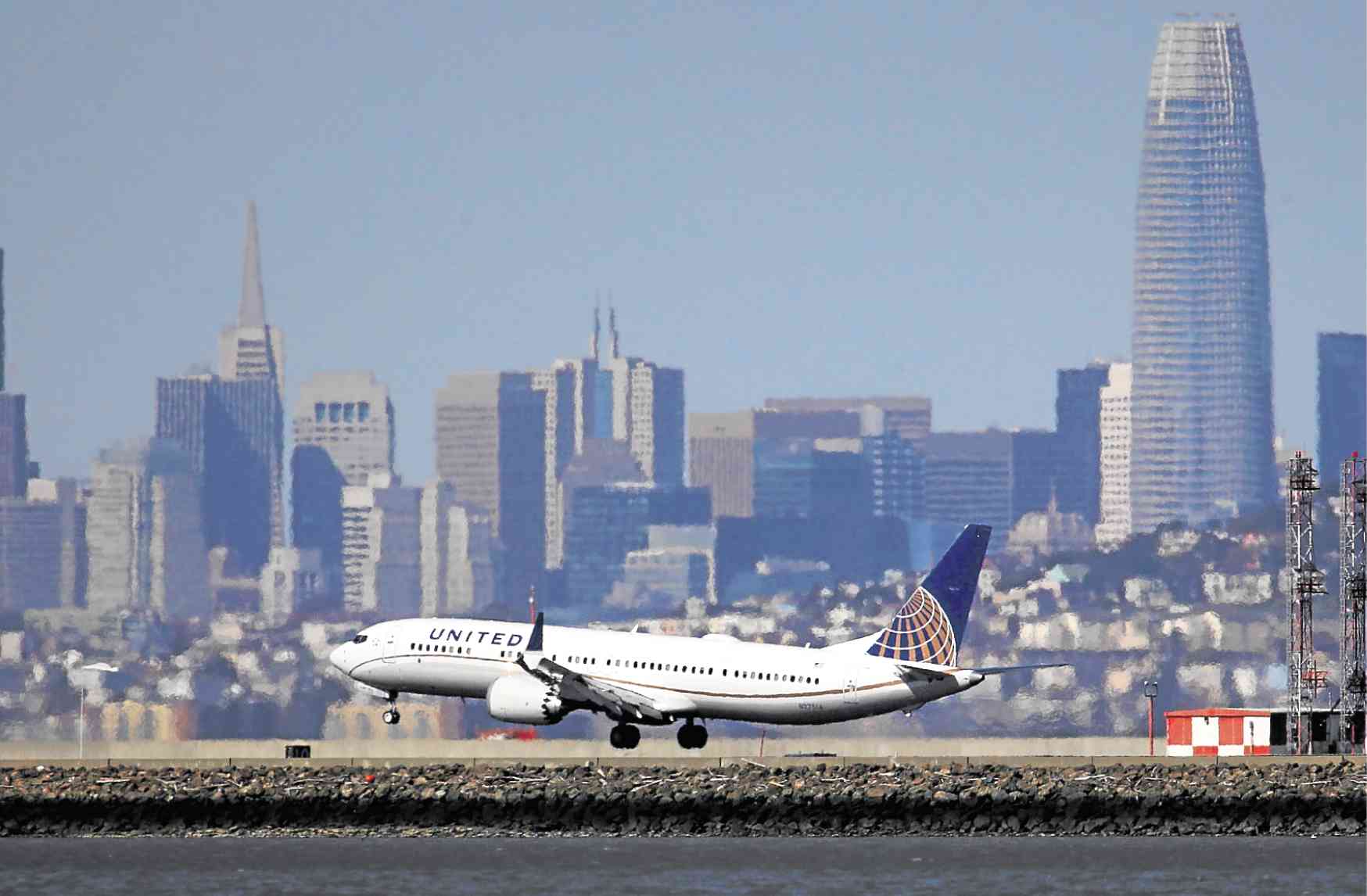
FLIGHT BAN A United Airlines Boeing 737 Max 9 aircraft lands at San Francisco International Airport on Wednesday in California. The United States has followed countries around the world and has grounded all Boeing 737 Max aircraft following a crash of an Ethiopia Airlines 737 Max 8. —AFP
WASHINGTON—The ban on the Boeing 737 MAX aircraft became worldwide on Wednesday after the United States joined Canada and other countries in grounding the aircraft amid mounting global fears for the jets’ airworthiness.
US authorities said new evidence showed similarities between Sunday’s deadly crash of an Ethiopian Airlines Boeing 737 MAX 8 and a fatal accident in Indonesia in October last year.
The Federal Aviation Administration (FAA) said findings from the crash site near Addis Ababa and “newly refined satellite data” warranted “further investigation of the possibility of a shared cause for the two incidents.”
An FAA emergency order grounded 737 MAX 8 and MAX 9 aircraft until further notice.
US paramount concern
US President Donald Trump told reporters at the White House the “safety of the American people and all peoples is our paramount concern.”
Mexico late Wednesday suspended MAX 8 and 9 operations, after Canada and Chile also joined the long list of countries to ban the plane from flying in their airspaces.
Many airlines have voluntarily taken it out of service.
Brazil, Costa Rica and Panama followed suit.
Ethiopia said it would send the black boxes from Flight ET 302 to France for analysis, which could provide crucial information about what happened.
“Hopefully they will come up with an answer but until they do the planes are grounded,” Trump said.
Determining the cause
FAA acting chief Daniel Elwell said the agency had been “working tirelessly” to determine the cause of the accident but faced delays because the black box flight data recorders had been damaged.
The new information shows “the track of that airplane was close enough to the track of the Lion Air flight… to warrant the grounding of the airplanes so we could get more information from the black boxes and determine if there’s a link between the two, and if there is, find a fix to that link,” Elwell said on CNBC.
Boeing chief Dennis Muilenburg said he supported the US decision “out of an abundance of caution” but continued to have “full confidence” in the safety of the plane.
The company continues its efforts “to understand the cause of the accidents in partnership with the investigators, deploy safety enhancements and help ensure this does not happen again,” Muilenburg said in a statement.
The accounts of the recent crashes were echoed in concerns registered by US pilots on how the MAX 8 behaves.
Pilots’ concerns
At least four American pilots made reports following the Lion Air crash, all complaining the aircraft suddenly pitched downward shortly after takeoff, according to documents reviewed by Agence France-Presse (AFP) on the Aviation Safety Reporting System, a voluntary incident database maintained by the National Aeronautics and Space Administration (Nasa).
In two anonymous reports on flights just after the Lion Air crash, pilots disconnected the autopilot and corrected the plane’s trajectory.
One said the flight crew reviewed the incident “at length… but can’t think of any reason the aircraft would pitch nose-down so aggressively.”
It was unclear if US transportation authorities review the database or investigate the incidents.
The FAA, however, said this week it had mandated that Boeing update its flight software and training on the aircraft.
Questions about the Lion Air crash have honed in on an automated stall prevention system, the MCAS, designed to automatically point the nose of the plane downward if it is in danger of stalling.
According to the flight data recorder, the pilots of Lion Air Flight 610 struggled to control the aircraft as the MCAS repeatedly pushed the plane’s nose down following takeoff.
The Ethiopian Airlines pilots reported similar difficulties before their aircraft plunged into the ground as they tried to return to the airport.
Boeing was criticized after the Lion Air crash for allegedly failing to adequately inform 737 pilots about the functioning of the stall prevention system.
Ethiopian Airlines CEO Tewolde GebreMariam on Sunday said the captain on the flight, Yared Mulugeta Getachew, 29, was an experienced aviator with more than 8,000 flight hours.
Not unintended
Andrew Hunter, a defense industry expert at the Center for Strategic and International Studies in Washington, said while Boeing and the FAA had good track records on dealing with safety concerns, sometimes the combination of automated systems and humans did not work smoothly.
“It is hard to get a system to work seamlessly with human beings,” he told AFP.
“The fact the system was fighting the pilot was not an unintended consequence,” he said, because it should counteract a pilot error and correcting this is “challenging.” —AFP